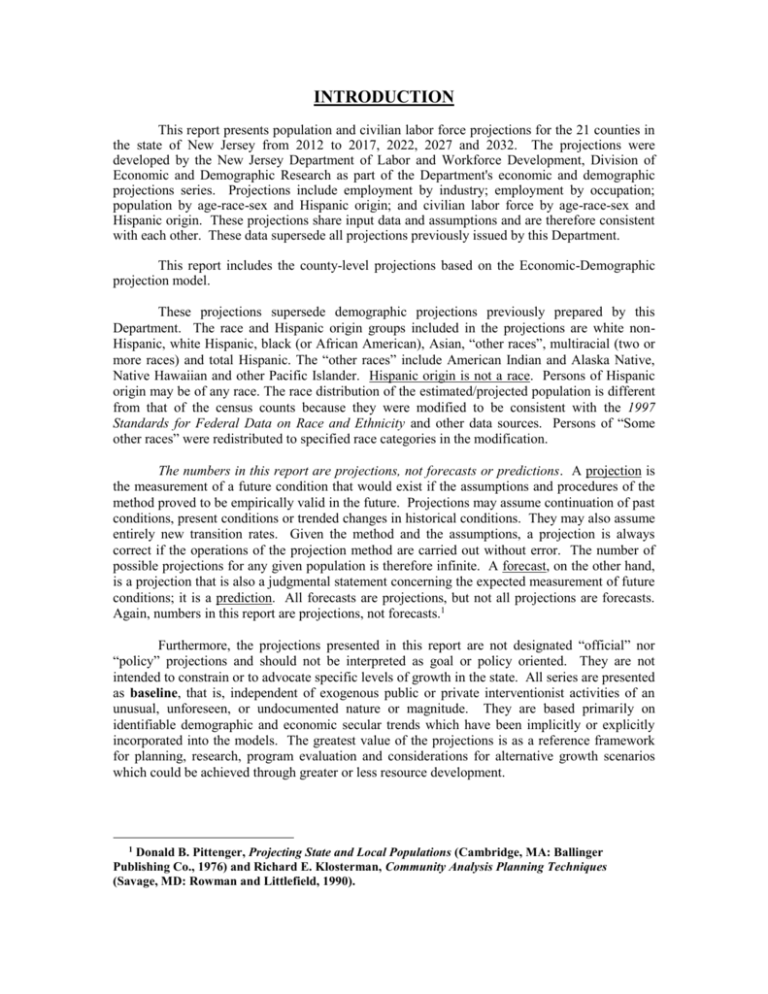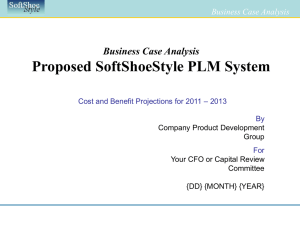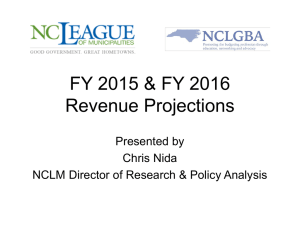
INTRODUCTION
This report presents population and civilian labor force projections for the 21 counties in
the state of New Jersey from 2012 to 2017, 2022, 2027 and 2032. The projections were
developed by the New Jersey Department of Labor and Workforce Development, Division of
Economic and Demographic Research as part of the Department's economic and demographic
projections series. Projections include employment by industry; employment by occupation;
population by age-race-sex and Hispanic origin; and civilian labor force by age-race-sex and
Hispanic origin. These projections share input data and assumptions and are therefore consistent
with each other. These data supersede all projections previously issued by this Department.
This report includes the county-level projections based on the Economic-Demographic
projection model.
These projections supersede demographic projections previously prepared by this
Department. The race and Hispanic origin groups included in the projections are white nonHispanic, white Hispanic, black (or African American), Asian, “other races”, multiracial (two or
more races) and total Hispanic. The “other races” include American Indian and Alaska Native,
Native Hawaiian and other Pacific Islander. Hispanic origin is not a race. Persons of Hispanic
origin may be of any race. The race distribution of the estimated/projected population is different
from that of the census counts because they were modified to be consistent with the 1997
Standards for Federal Data on Race and Ethnicity and other data sources. Persons of “Some
other races” were redistributed to specified race categories in the modification.
The numbers in this report are projections, not forecasts or predictions. A projection is
the measurement of a future condition that would exist if the assumptions and procedures of the
method proved to be empirically valid in the future. Projections may assume continuation of past
conditions, present conditions or trended changes in historical conditions. They may also assume
entirely new transition rates. Given the method and the assumptions, a projection is always
correct if the operations of the projection method are carried out without error. The number of
possible projections for any given population is therefore infinite. A forecast, on the other hand,
is a projection that is also a judgmental statement concerning the expected measurement of future
conditions; it is a prediction. All forecasts are projections, but not all projections are forecasts.
Again, numbers in this report are projections, not forecasts.1
Furthermore, the projections presented in this report are not designated “official” nor
“policy” projections and should not be interpreted as goal or policy oriented. They are not
intended to constrain or to advocate specific levels of growth in the state. All series are presented
as baseline, that is, independent of exogenous public or private interventionist activities of an
unusual, unforeseen, or undocumented nature or magnitude. They are based primarily on
identifiable demographic and economic secular trends which have been implicitly or explicitly
incorporated into the models. The greatest value of the projections is as a reference framework
for planning, research, program evaluation and considerations for alternative growth scenarios
which could be achieved through greater or less resource development.
1
Donald B. Pittenger, Projecting State and Local Populations (Cambridge, MA: Ballinger
Publishing Co., 1976) and Richard E. Klosterman, Community Analysis Planning Techniques
(Savage, MD: Rowman and Littlefield, 1990).
Presentation of Results
This report provides summary tables for all counties including total population (Table 1)
and civilian labor force (Table 8), as well as some details by age (Tables 2 and 9), sex (Tables 3
and 10), age and sex (Tables 4 and 11), race and Hispanic origin (Tables 5 and 12) and race-sexorigin (Tables 6 and 13) for population and labor force based on the Economic-Demographic
Model. The detailed projections of population and civilian labor force by age, race, sex and
Hispanic origin are given in Tables 7 and 14, respectively. Data by the same racial groups were
tabulated for both population and labor force. However, labor force is divided into 6 age groups
while population consists of 18 age groups. Because of rounding, there may be small
discrepancies between projection distributions and totals.
No hardcopy of this publication is prepared. The county projections data are only
available online at the Office of Labor Planning and Analysis’ Labor Fast Facts web site
(http://lwd.dol.state.nj.us/labor/lpa/dmograph/lfproj/lfproj_index.html).
Caution on Interpretation
As noted at the outset, projections are not forecasts. In addition, they are not designated
“official”, nor “policy” projections. The employment projections for the state are available for
the year 2022 only. Particular caution is advised in interpreting results for 2017, 2027 and 2032.
Although they were consistent with the interpolated and extrapolated employment projections for
the corresponding years, no actual employment projections were developed for these years. Users
of any long-term projections should also be advised that the plausibility of historically based
assumptions declines with increasing departure from the base year. Projections are by their
nature biased in favor of continuity. There is generally little basis for projecting substantial
departures from past trends, so few such departures are projected. Yet, there is little doubt that
unforeseen changes will occur. Dramatic changes or disruptions of the current and/or recent
economic-demographic conditions in the future such as major natural disasters, wars or a major
overhaul of the nation’s immigration policies, etc. may invalidate the projections.
The Division of Economic and Demographic Research hopes the users of these
projections will comment on them. Please direct all comments, suggestions and data requests to
New Jersey Department of Labor and Workforce Development, Division of Economic and
Demographic Research, P O Box 388, Trenton, New Jersey 08625-0388; phone: 609-292-0076;
e-mail: sywu@dol.state.nj.us.
List of Tables
Table 1. Projections of Total Population by County: New Jersey, 2012 to 2032
Table 2. Projections of County Population by Age: New Jersey, 2012 to 2032
Table 3. Projections of County Population by Sex: New Jersey, 2012 to 2032
Table 4. Projections of County Population by Age and Sex: New Jersey, 2012 to 2032
Table 5. Projections of County Population by Race and Hispanic Origin:
New Jersey, 2012 to 2032
Table 6. Projections of County Population by Race, Sex and Hispanic Origin:
New Jersey, 2012 to 2032
Table 7. Projections of County Population by Age, Race, Sex and Hispanic Origin
New Jersey: 2012 to 2032
Table 8. Projections of Civilian Labor Force by County: New Jersey, 2012 to 2032
Table 9. Projections of County Labor Force by Age: New Jersey, 2012 to 2032
Table 10. Projections of County Labor Force by Sex: New Jersey, 2012 to 2032
Table 11. Projections of County Labor Force by Age and Sex: New Jersey, 2012 to 2032
Table 12. Projections of County Labor Force by Race and Hispanic Origin:
New Jersey, 2012 to 2032
Table 13. Projections of County Labor Force by Race, Sex and Hispanic Origin:
New Jersey, 2012 to 2032
Table 14. Projections of County Labor Force by Age, Race, Sex and Hispanic Origin
New Jersey: 2012 to 2032







